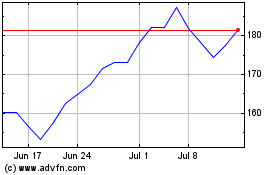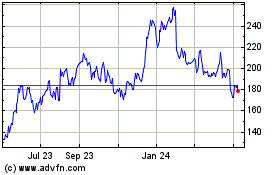Atlassian Releases 2nd Annual Sustainability Report, Sets Ambitious Goals to Fight Climate Crisis
December 07 2020 - 3:30PM
Business Wire
Atlassian Corporation Plc (NASDAQ: TEAM), a leading provider of
team collaboration and productivity software, today released its
second annual Sustainability Report for the fiscal year 2020 and
announced ambitious goals to combat global climate change.
This report, which covers our progress from July 1, 2019, to
June 30, 2020, details Atlassian’s progress and trajectory across
four sustainability pillars: planet, customers, people, and
community.
The report includes deeper disclosures and data across all
pillars and includes Atlassian’s diversity, equity, and inclusion
reporting, instead of having two separate documents. We believe any
sincere sustainability efforts must acknowledge the interlocking
impacts of climate change, structural racial and gender inequality,
and widening social and economic gaps – and this reflects how our
team works. We can’t treat these issues as siloed challenges; they
influence and amplify one another.
As we state in the report, we have a long-standing commitment to
being a company focused on the long term. This is why we’re as just
as committed to sustainability as we are to our products. We think
about it as embedding the goal of social and environmental progress
in everything we do.
As part of our commitment to combat climate change, Atlassian
set a goal to reach 100 percent renewable power across all our
operations by 2025, which we achieved in the fiscal year 2020, five
years ahead of schedule.
“We are setting ambitious climate goals because we believe in
matching our words by stepping up and taking action, said Jessica
Hyman, Atlassian’s head of sustainability. “It’s what our staff
want. It’s what our customers expect. It’s what our politicians
should be doing. And it’s what we must do for the future
sustainability of our business.”
In September 2019, at UN Climate Week, we committed to set a
target to reach net-zero emissions by no later than 2050. We
aligned our goals with a 1.5°C trajectory as part of our commitment
to the Business Ambition for 1.5°C campaign, reflecting the most
ambitious objectives of the Paris Agreement.
Last week we announced that these goals have been approved by
the Science Based Targets Initiative steering committee. It’s
incredibly important to go through the process of figuring out
exactly how much we need to reduce carbon emissions to meet our
commitments.
“We congratulate Atlassian Corporation for setting emissions
reduction targets consistent with limiting warming to 1.5°C, the
most ambitious goal of the Paris Agreement, said Alexander Farsan,
global lead for Science Based Targets at World Wide Fund for
Nature. “By setting targets that are grounded in climate science,
Atlassian is setting themselves up for success in the transition to
a net-zero economy.”
We were one of the first Australian companies to sign the 1.5
campaign, making a massive commitment to transform our business.
And with 5,000 Atlassians in multiple offices, countries, and
continents, we will have to make big changes to our direct and
indirect operations to reach this goal. We’re doing this because we
believe in reinforcing our words with action and leaving the planet
in a better state for future generations.
Our SBTi validation is an important step in our climate
leadership and commitment to science. Here are the key ways we
believe we can get there by 2050:
Scope 1-2 – Absolute Emissions Reduction
of 50 percent by 2025: This will mostly be achieved through
procurement of 100 percent renewable energy and is therefore
directly aligned with our RE100 commitment. The other critical
element is ensuring any of the buildings we own and operate run on
electricity for heating and cooling (as opposed to natural gas or
diesel).
Scope 3 – Reduce absolute emissions from
business travel 25 percent by 2025: This will be achieved by
reducing emissions from business travel, with a big focus on air
travel. We’ll need to consider how to shift travel policy and team
behavior, in the context of Team Anywhere, in order to achieve our
goal. There is also an opportunity to work with airlines to
advocate for more renewable aviation fuels.
Scope 3 – 65 percent of suppliers by
emissions will have SBTs by fiscal year 2025: This will be
achieved through supply chain management. We’ll need to engage with
our top suppliers and encourage them to set science-based climate
targets. We are in the middle of mapping out our priorities here
with our internal teams, and we’re looking forward to the
opportunity for innovation in this space.
One of our values at Atlassian is “Open Company, No Bullshit.”
One thing we know for certain: we aren’t going to get this right
the first time. But we are committed to being open and honest about
our journey and sharing what we learn with the business
community.
“Our hope is that more companies see this is possible, and take
the leap, said Mike Cannon-Brookes, Atlassian co-founder and
co-CEO. “The latest climate science says we need reductions to keep
warming to 1.5 degrees to avoid the most damaging effects of
climate change. Australia needs to do its part. Our future depends
on it.”
About Atlassian
Atlassian unleashes the potential of every team. Our team
collaboration and productivity software helps teams organize,
discuss, and complete shared work. Teams at more than 182,000
customers, across large and small organizations - including
Honeywell, Dropbox, Bank of America, Redfin, Verizon, and NASA -
use Atlassian’s project tracking, content creation and sharing, and
service management products to work better together and deliver
quality results on time. Learn more about our products, including
Jira Software, Confluence, Trello, Bitbucket, Opsgenie, Jira
Service Desk, and Jira Align at https://atlassian.com/.
View source
version on businesswire.com: https://www.businesswire.com/news/home/20201207005910/en/
Jake Standish press@atlassian.com
Atlassian (NASDAQ:TEAM)
Historical Stock Chart
From Mar 2024 to Apr 2024

Atlassian (NASDAQ:TEAM)
Historical Stock Chart
From Apr 2023 to Apr 2024
